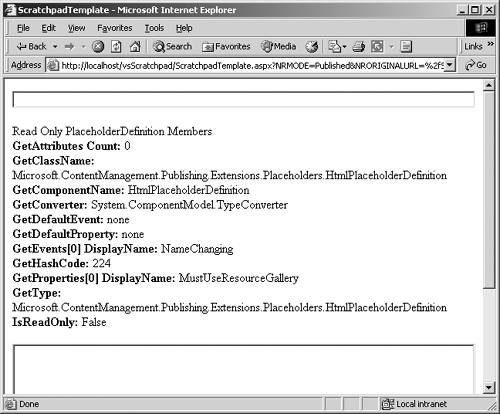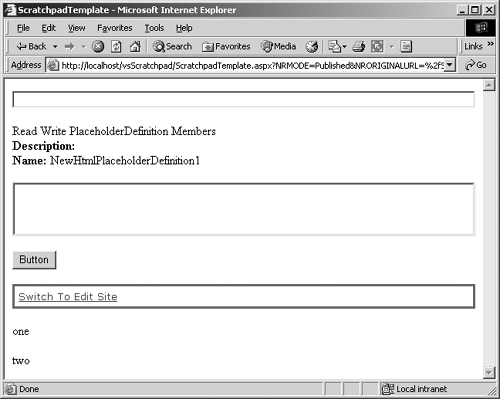Working with PlaceholderDefinition Members
| We will use the same approach with PlaceholderDefinition that we took with Placeholder: read-only members first followed by nonprotected read/write members. Read-Only MembersThe code to see all the read-only PlaceholderDefinition members is presented comprehensively. Replace the Button1_Click function of our Scratchpad template file with the following code: private void Button1_Click(object sender, System.EventArgs e) { //1. Put current Template into variable Template cmsTemplate = CmsHttpContext.Current.Posting.Template; //2. Grab the first PlaceholderDefinition to view PlaceholderDefinition cmsDefinition = cmsTemplate.PlaceholderDefinitions[0] as PlaceholderDefinition; //3. Check to see if we found the specified PlaceholderDefinition if (cmsDefinition != null) { //4. Populate the label with the read-only properties Label1.Text = "Read Only PlaceholderDefinition Members"; //5. Add to label info about GetAttributes if (cmsDefinition.GetAttributes() != null) if (cmsDefinition.GetAttributes().Count > 0) Label1.Text += "<br><b>GetAttributes[0] TypeID: </b>" + cmsDefinition.GetAttributes()[0].TypeId.ToString(); else Label1.Text += "<br><b>GetAttributes Count: </b>" + cmsDefinition.GetAttributes().Count.ToString(); else Label1.Text += "<br><b>GetAttributes: </b>none"; //6. Add to label info about GetClassName Label1.Text += "<br><b>GetClassName: </b>" + cmsDefinition.GetClassName().ToString(); //7. Add to label info about GetComponentName Label1.Text += "<br><b>GetComponentName: </b>" + cmsDefinition.GetComponentName().ToString(); //8. Add to label info about GetConverter Label1.Text += "<br><b>GetConverter: </b>" + cmsDefinition.GetConverter().ToString(); //9. Add to label info about GetDefaultEvent if (cmsDefinition.GetDefaultEvent() != null) Label1.Text += "<br><b>GetDefaultEvent DisplayName: </b>" + cmsDefinition.GetDefaultEvent().DisplayName.ToString(); else Label1.Text += "<br><b>GetDefaultEvent: </b>none"; //10. Add to label info about GetDefaultProperty if (cmsDefinition.GetDefaultProperty() != null) Label1.Text += "<br><b>GetDefaultProperty: </b>" + cmsDefinition.GetDefaultEvent().ToString(); else Label1.Text += "<br><b>GetDefaultProperty: </b>none"; //11. Add to label info about GetClassName if (cmsDefinition.GetEvents() != null) if (cmsDefinition.GetEvents().Count > 0) Label1.Text += "<br><b>GetEvents[0] DisplayName: </b>" + cmsDefinition.GetEvents()[0].DisplayName.ToString(); else Label1.Text += "<br><b>GetEvents Count: </b>" + cmsDefinition.GetEvents().Count.ToString(); else Label1.Text += "<br><b>GetEvents: </b>none"; //12. Add to label info about GetHashCode Label1.Text += "<br><b>GetHashCode: </b>" + cmsDefinition.GetHashCode().ToString(); //13. Add to label info about GetProperties if (cmsDefinition.GetProperties() != null) if (cmsDefinition.GetProperties().Count > 0) Label1.Text += "<br><b>GetProperties[0] DisplayName: " + "</b>" + cmsDefinition.GetProperties()[0].DisplayName .ToString(); else Label1.Text += "<br><b>GetProperties Count: </b>" + cmsDefinition.GetProperties().Count.ToString(); else Label1.Text += "<br><b>GetProperties: </b>none"; //14. Add to label info about GetType Label1.Text += "<br><b>GetType: </b>" + cmsDefinition.GetType().ToString(); //15. Add to label info about IsReadOnly Label1.Text += "<br><b>IsReadOnly: </b>" + cmsDefinition.IsReadOnly.ToString(); } } Build the solution and then refresh the Scratchpad posting in Internet Explorer, or browse to it and click the Button. The page should reload and look similar to Figure 27-8. Figure 27-8. Read-only PlaceholderDefinition members
Read-Only Members for a PlaceholderDefinitionAll of the following properties are inherited from the CustomReflectionObject:
GetHashCode, GetTypeThe same as Placeholder. IsReadOnlyThe IsReadOnly property retrieves the Boolean value that indicates whether the PlaceholderDefinition can be modified or not. If it returns true, the PlaceholderDefinition is read-only, and any attempt to set a property will result in an exception. A PlaceholderDefinition can become read-only if it is cloned with the optional parameter set to true. Read/Write MembersAs before, the code to see all the read/write PlaceholderDefinition members is presented comprehensively. All these members can be assigned a value in code or through various other user interfaces. However, none of these changed values will become permanent until CommitAll is called on the Context. Uncommitted changes can be discarded by calling RollbackAll. If neither method is explicitly called when the Context in which the change is made is destroyed (goes out of scope or is disposed of), the disposition of the changes will be decided by the value of the RollbackOnSessionEnd property. By default, this property is false, so all changes are committed. In general, the properties of deleted or marked-for-delete PlaceholderDefinitions and historical revisions can't be altered. Properties can only be altered when the PlaceholderDefinition is retrieved from the PlaceholderDefinitions collection property of a Template object rather than the Definition property of a Posting object's Placeholder property. Of course, the user must have sufficient rights (the Posting object's CanSetProperties property must return true), and the mode must be in Update PublishingMode. Setting a property may change the state of a template and any ConnectedTemplates. Replace the Button1_Click function of our Scratchpad template file with the following code: private void Button1_Click(object sender, System.EventArgs e) { //1. Put current Template into variable Template cmsTemplate = CmsHttpContext.Current.Posting.Template; //2. Grab the first PlaceholderDefinition to view PlaceholderDefinition cmsDefinition = cmsTemplate.PlaceholderDefinitions[0] as PlaceholderDefinition; //3. Check to see if we found the specified PlaceholderDefinition if (cmsDefinition != null) { //4. Populate the label with the read-only properties Label1.Text = "Read Write PlaceholderDefinition Members"; //5. Add to the label with PlaceholderDefinition Description Label1.Text += "<br><b>Description: </b>" + HttpUtility.HtmlEncode(cmsDefinition.Description.ToString()); //6. Add to the label with PlaceholderDefinition Name Label1.Text += "<br><b>Name: </b>" + HttpUtility.HtmlEncode(cmsDefinition.Name.ToString()); } } Build the solution and then refresh the Scratchpad posting in Internet Explorer, or browse to it and click the Button. The page should reload and look similar to Figure 27-9. Figure 27-9. Read/write PlaceholderDefinition members
Read/Write Members for a PlaceholderDefinitionAs with Placeholders, BeginWrite, EndWrite, and BeginRead are all protected members that are accessed by the PlaceholderDefinition-specific classes on our behalf. Suffice it to say that altering members for a PlaceholderDefinition object requires the implementation and calling of the BeginWrite method to start the process and validate that the user has sufficient rights to update the PlaceholderDefinition. To save a modified PlaceholderDefinition object requires the implementation and calling of the EndWrite method. BeginRead should be implemented and called whenever a PlaceholderDefinition property is read. The OnCloned method can be implemented to create a proprietary solution when a PlaceholderDefinition is cloned. If this method is implemented, it overrides the default behavior discussed earlier in this chapter. Description (Inherited from HierarchyItem)The Description property holds the free-form text description (see the Avoid Hack by Using HtmlEncode sidebar in Chapter 25) for the referencing PlaceholderDefinition. CMS automatically trims leading and trailing spaces and truncates the length to 500 characters for any string assigned to this property. Typical alphanumeric characters are allowed. This member can be useful for setting and showing a verbose description of the PlaceholderDefinition that the user is using. Name (Inherited from HierarchyItem)The Name property holds the free-form text of the actual name for the referencing PlaceholderDefinition. This name is not intended for display (see the Avoid Hack by Using HtmlEncode sidebar) per se but is visible to the user in the URL and Path. This property is not allowed to be empty and must be case-insensitive unique within the collection. CMS automatically trims leading and trailing spaces and truncates the length to 100 characters for any string assigned to this property. Typical alphanumeric characters are allowed, but we recommend against using spaces in PlaceholderDefinition names. This member can be useful for setting and showing the Name of the PlaceholderDefinition. |
EAN: 2147483647
Pages: 298

